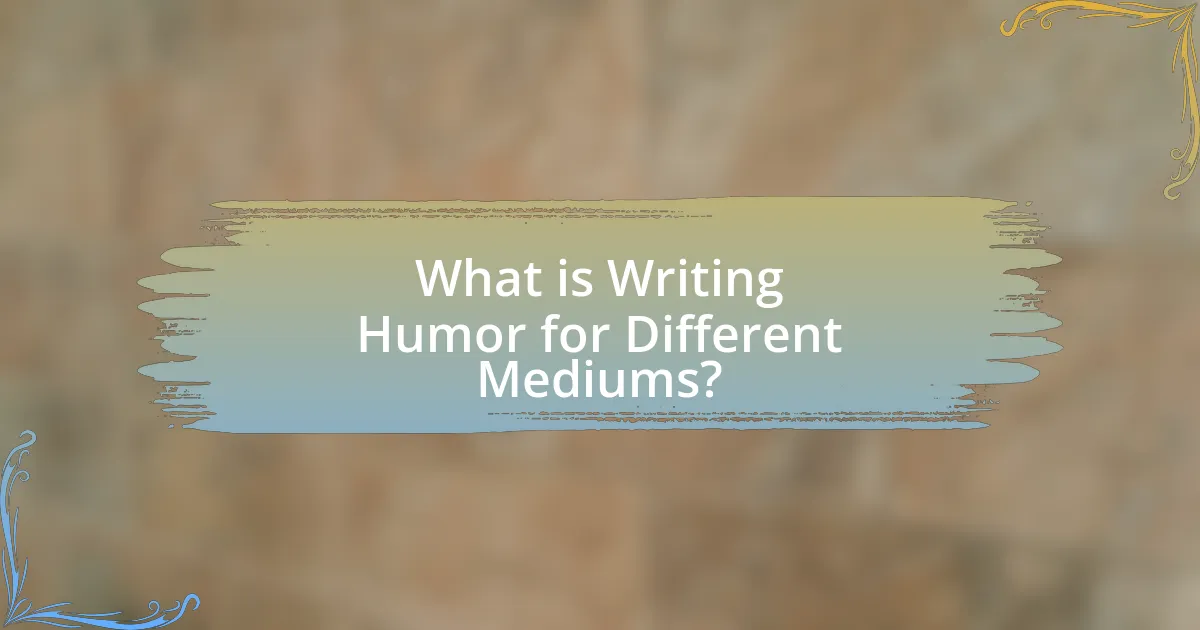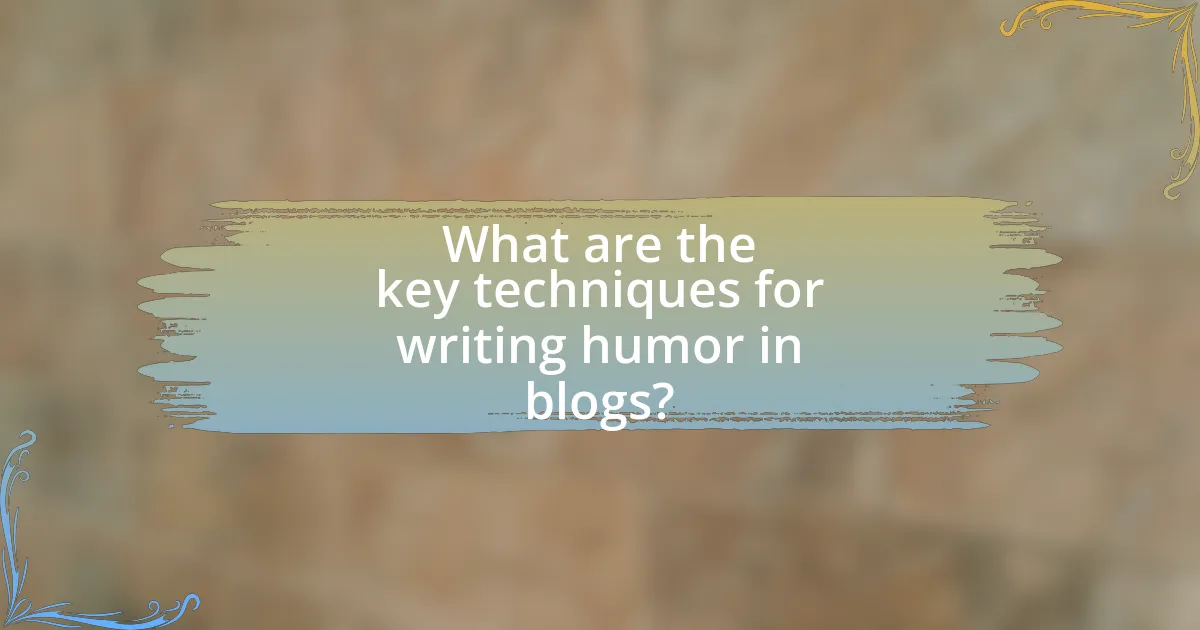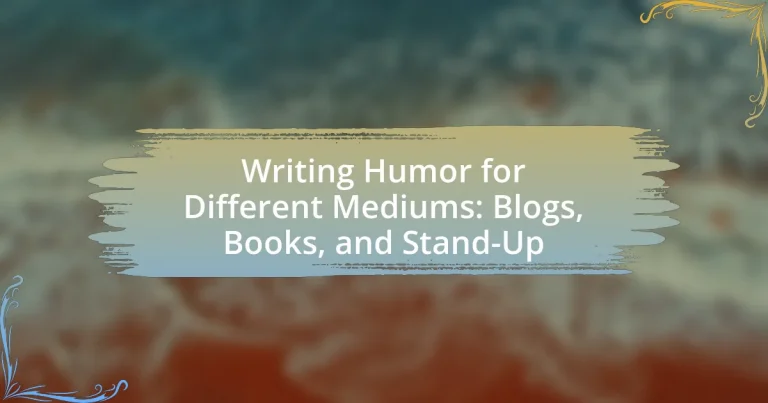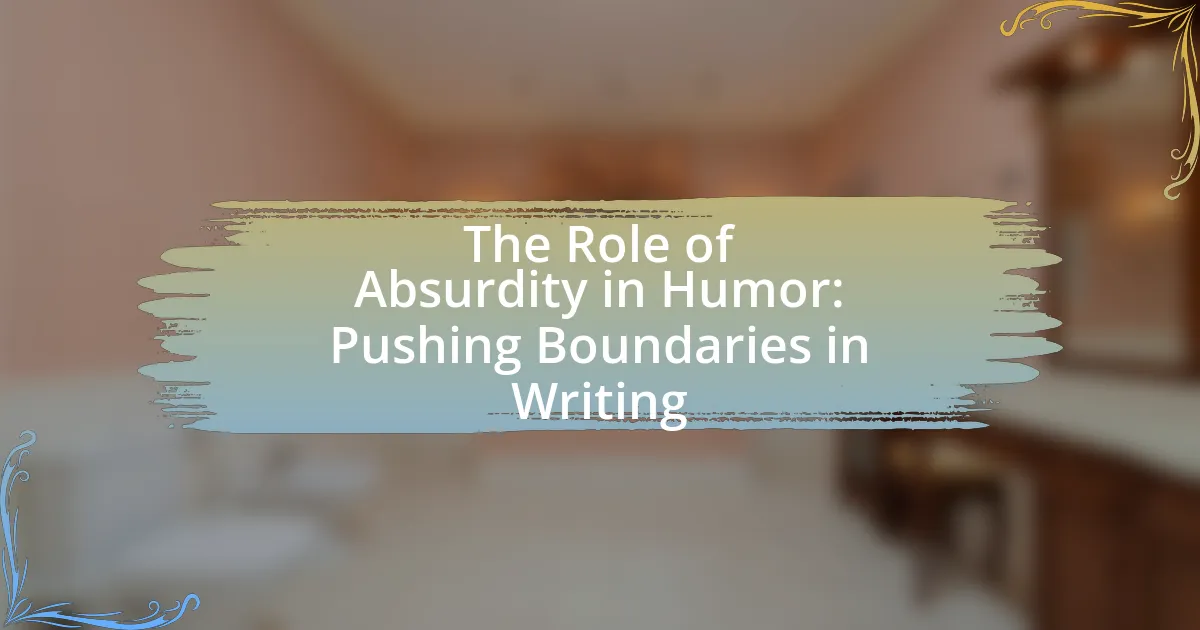The article focuses on the nuances of writing humor across different mediums, specifically blogs, books, and stand-up comedy. It outlines how humor varies in each format, emphasizing the importance of audience engagement, timing, and delivery style. Key characteristics of humor in blogs include relatability and brevity, while books allow for more complex narratives and character-driven comedy. Stand-up comedy relies heavily on performance elements such as timing and audience interaction. The article also discusses techniques for effective humor writing, the role of personal anecdotes, and the significance of understanding audience expectations to enhance comedic impact.

What is Writing Humor for Different Mediums?
Writing humor for different mediums involves tailoring comedic content to fit the unique characteristics and audience expectations of each format, such as blogs, books, and stand-up comedy. Each medium requires distinct approaches; for instance, blogs often utilize concise, relatable anecdotes or witty observations to engage readers quickly, while books may allow for more elaborate storytelling and character development to build humor over time. Stand-up comedy relies heavily on timing, delivery, and audience interaction, necessitating a performance-oriented style that emphasizes punchlines and physicality. The effectiveness of humor in these mediums is supported by research indicating that audience engagement varies significantly across formats, with studies showing that humor in written forms can enhance reader retention and enjoyment, while live performances can create a shared experience that amplifies comedic impact.
How does humor vary across blogs, books, and stand-up?
Humor varies significantly across blogs, books, and stand-up due to differences in audience engagement, format, and delivery style. In blogs, humor often relies on brevity and relatability, using conversational language to connect with readers quickly. For example, a humorous blog post may include witty observations or personal anecdotes that resonate with a specific audience. In contrast, books allow for more in-depth exploration of humor, often employing narrative techniques, character development, and situational comedy to build a comedic arc over a longer format. Stand-up comedy, however, focuses on live performance, where timing, delivery, and audience interaction are crucial; comedians often adapt their material based on audience reactions, making humor more spontaneous and dynamic. This variance is supported by research indicating that the effectiveness of humor is context-dependent, with different mediums requiring tailored approaches to engage audiences effectively.
What are the defining characteristics of humor in blogs?
The defining characteristics of humor in blogs include relatability, brevity, and conversational tone. Relatability allows readers to connect with the content, often through shared experiences or observations, making the humor more impactful. Brevity is crucial as blog readers typically prefer concise content; effective humor often relies on punchy, quick-witted lines that maintain engagement. A conversational tone enhances the humor by creating an informal atmosphere, making the reader feel as if they are part of a dialogue rather than just consuming information. These characteristics are supported by studies indicating that humor that resonates with personal experiences and is delivered in a friendly manner increases reader retention and enjoyment.
How does humor in books differ from that in blogs?
Humor in books typically employs more developed narratives and character arcs, while humor in blogs often relies on brevity and immediacy. Books can explore complex themes and use humor as a tool for deeper character development, allowing for nuanced jokes that resonate over longer passages. In contrast, blogs prioritize quick, punchy humor that engages readers instantly, often using current events or relatable scenarios to elicit laughter. This difference is supported by the structure of each medium; books allow for extensive storytelling, while blogs cater to fast consumption, reflecting the reader’s preference for quick entertainment.
What unique elements define stand-up comedy humor?
Stand-up comedy humor is defined by its reliance on personal anecdotes, observational humor, and timing. Personal anecdotes allow comedians to connect with the audience through relatable experiences, while observational humor highlights everyday situations in a humorous light. Timing, including pauses and delivery speed, is crucial in maximizing comedic effect. Research indicates that effective timing can enhance audience laughter by up to 50%, demonstrating its importance in stand-up performances.
Why is understanding different mediums important for humor writing?
Understanding different mediums is crucial for humor writing because each medium has unique characteristics that influence how humor is delivered and received. For instance, stand-up comedy relies heavily on timing, audience interaction, and physical presence, while written formats like blogs or books allow for more nuanced language and pacing. Research indicates that humor effectiveness varies significantly across mediums; a study published in the Journal of Communication found that audience engagement and humor appreciation differ based on the format, highlighting the need for writers to adapt their style accordingly. Therefore, recognizing these distinctions enables humor writers to tailor their content to maximize impact and resonance with their audience.
How does audience expectation influence humor in various formats?
Audience expectation significantly influences humor across various formats by shaping the context and delivery of comedic content. In stand-up comedy, performers often tailor their material to the demographic and cultural background of the audience, as evidenced by research indicating that humor is more effective when it aligns with the audience’s values and experiences. For instance, a study published in the Journal of Personality and Social Psychology found that humor that resonates with the audience’s social identity enhances enjoyment and relatability. In blogs, writers must consider the readers’ preferences and expectations regarding tone and style; humor that is too niche may alienate a broader audience. Similarly, in books, authors often gauge the expected humor style based on genre conventions, as seen in the popularity of witty dialogue in contemporary fiction. Thus, understanding audience expectation is crucial for effectively crafting humor that engages and entertains across different mediums.
What role does timing play in humor across different mediums?
Timing is crucial in humor across different mediums as it dictates the delivery and impact of a joke or comedic element. In stand-up comedy, for instance, precise timing can enhance the punchline’s effectiveness, as evidenced by comedians like George Carlin, who mastered the art of timing to maximize audience laughter. In written formats like blogs and books, timing manifests through pacing and the strategic placement of humorous content, allowing readers to absorb and react to the humor effectively. Research indicates that well-timed humor can increase engagement and retention, highlighting its importance in various contexts. Thus, timing serves as a fundamental component that shapes the effectiveness of humor across mediums.

What are the key techniques for writing humor in blogs?
The key techniques for writing humor in blogs include using relatable anecdotes, employing wordplay, and incorporating exaggeration. Relatable anecdotes create a connection with readers by reflecting shared experiences, making the humor more impactful. Wordplay, such as puns and clever phrasing, adds a layer of wit that engages the audience. Exaggeration amplifies situations to absurd levels, enhancing comedic effect. These techniques are supported by studies indicating that humor increases reader engagement and retention, making blogs more memorable and enjoyable.
How can writers effectively engage readers with humor in blogs?
Writers can effectively engage readers with humor in blogs by using relatable anecdotes, clever wordplay, and observational humor. These techniques create a connection with the audience, making the content more enjoyable and memorable. For instance, incorporating personal stories that highlight everyday situations allows readers to see themselves in the narrative, fostering a sense of camaraderie. Additionally, employing puns or witty remarks can add a light-hearted tone that keeps readers entertained. Research indicates that humor can enhance reader retention and increase the likelihood of sharing content, as demonstrated in studies by the Journal of Marketing Research, which found that humorous advertisements are more likely to be remembered and shared.
What types of humor work best in blog formats?
Conversational humor works best in blog formats. This type of humor engages readers through relatable anecdotes, witty observations, and informal language, making the content feel personal and accessible. Studies show that conversational humor increases reader retention and encourages sharing, as it resonates with audiences on a personal level. Additionally, incorporating self-deprecating humor can enhance relatability, allowing readers to connect with the author’s experiences. Overall, humor that feels genuine and conversational is most effective in blog formats.
How can personal anecdotes enhance humor in blogs?
Personal anecdotes enhance humor in blogs by providing relatable and authentic experiences that resonate with readers. When bloggers share personal stories, they create a connection with their audience, making the humor more impactful and engaging. Research indicates that humor is often more effective when it is grounded in personal experience, as it fosters a sense of familiarity and trust. For instance, a study published in the Journal of Humor Research found that humor derived from personal anecdotes is perceived as more genuine and can lead to increased reader engagement and enjoyment. This connection not only amplifies the comedic effect but also encourages readers to share the content, further spreading the humor.
What common pitfalls should be avoided when writing humorous blogs?
When writing humorous blogs, common pitfalls to avoid include relying on clichés, which can make humor feel stale and unoriginal. Additionally, failing to understand the target audience can lead to humor that misses the mark, as what is funny to one group may not resonate with another. Overcomplicating jokes or using excessive wordplay can confuse readers, detracting from the humor. Furthermore, being overly self-indulgent or focusing too much on personal anecdotes without broader relevance can alienate readers. Lastly, neglecting the importance of editing can result in poorly structured content that undermines comedic timing and effectiveness.
How can over-exaggeration detract from humor in blogs?
Over-exaggeration can detract from humor in blogs by making the content feel unrealistic and less relatable to readers. When humor relies heavily on exaggerated scenarios, it risks alienating the audience, as they may struggle to connect with the absurdity presented. Research indicates that effective humor often hinges on a balance between truth and exaggeration; if the exaggeration overshadows the truth, it can lead to confusion rather than laughter. For instance, a study published in the Journal of Humor Research highlights that humor is most effective when it resonates with the audience’s experiences, suggesting that excessive exaggeration can undermine this connection.
What are the risks of using offensive humor in blog writing?
Using offensive humor in blog writing poses significant risks, including alienating readers, damaging the writer’s reputation, and potentially facing backlash or legal consequences. Offensive humor can lead to a loss of audience engagement, as studies show that 70% of readers prefer content that is inclusive and respectful. Additionally, a blog that employs offensive humor may attract negative attention on social media, resulting in public criticism and loss of credibility. Furthermore, depending on the nature of the humor, it could violate platform guidelines, leading to content removal or account suspension.

How do you craft humor for books?
To craft humor for books, writers should focus on relatable situations, character-driven comedy, and clever wordplay. Relatable situations resonate with readers, making them laugh at shared experiences. Character-driven comedy relies on well-developed characters whose quirks and flaws create humorous scenarios, as seen in works like “The Hitchhiker’s Guide to the Galaxy” by Douglas Adams. Clever wordplay, including puns and double entendres, adds layers of humor, exemplified in the writing of authors like P.G. Wodehouse. By combining these elements, writers can effectively engage readers and elicit laughter throughout their narratives.
What are the essential elements of humor in book writing?
The essential elements of humor in book writing include timing, relatability, exaggeration, and wit. Timing involves the strategic placement of jokes or humorous observations to maximize impact, as seen in comedic novels where punchlines are often delivered at pivotal moments. Relatability ensures that the humor resonates with the audience’s experiences, making it more effective; for instance, authors like David Sedaris often draw on everyday situations that readers can identify with. Exaggeration amplifies characteristics or situations to absurd levels, creating humor through contrast with reality, a technique frequently employed by authors such as Roald Dahl. Wit, characterized by clever wordplay and intelligent humor, adds depth and sophistication to the narrative, as demonstrated in the works of Jane Austen. These elements collectively enhance the comedic effect and engage readers effectively.
How does character development contribute to humor in books?
Character development significantly contributes to humor in books by creating relatable and multi-dimensional characters whose quirks and flaws can lead to comedic situations. When authors invest time in developing characters, they establish unique personalities, backgrounds, and motivations that can generate humor through their interactions and conflicts. For instance, a character’s exaggerated traits, such as a clumsy hero or a sarcastic sidekick, can lead to humorous scenarios that resonate with readers. Additionally, well-developed characters often find themselves in absurd situations that highlight their weaknesses, making the humor more impactful. This connection between character depth and humor is evident in works like “The Hitchhiker’s Guide to the Galaxy” by Douglas Adams, where the eccentricities of characters like Arthur Dent amplify the comedic elements throughout the narrative.
What narrative techniques can enhance comedic effect in books?
Narrative techniques that can enhance comedic effect in books include exaggeration, incongruity, and timing. Exaggeration amplifies characteristics or situations to absurd levels, making them humorous; for example, a character might have an irrational fear of something trivial, which highlights their quirks. Incongruity involves placing characters or situations in unexpected contexts, creating humor through surprise; for instance, a serious character might find themselves in a ridiculous scenario, leading to comedic tension. Timing, particularly in dialogue, is crucial; well-placed pauses or rapid exchanges can heighten the comedic impact. These techniques are supported by comedic theory, which emphasizes the role of surprise and contrast in humor, as seen in works by authors like Douglas Adams and Terry Pratchett, who effectively utilize these methods to elicit laughter.
How can pacing and structure affect humor in books?
Pacing and structure significantly influence humor in books by controlling the timing and delivery of comedic elements. Effective pacing allows for the buildup of tension before a punchline, creating a more impactful humorous effect. For instance, a well-timed pause before a joke can enhance its surprise and comedic value. Additionally, the structure of a narrative, including the arrangement of scenes and the development of characters, can set the stage for humor by establishing expectations that can be subverted for comedic effect. Research indicates that comedic timing, which is closely linked to pacing, is crucial for eliciting laughter, as shown in studies on audience reactions to comedic performances. Thus, both pacing and structure are essential tools for writers aiming to craft humor that resonates with readers.
What is the importance of timing in comedic storytelling?
Timing is crucial in comedic storytelling as it directly influences the effectiveness of humor. Proper timing enhances punchlines, allowing the audience to react at the right moment, which maximizes laughter. Research indicates that comedic timing can be measured in milliseconds; for instance, a study published in the journal “Cognition” by researchers at the University of California found that a delay of just 200 milliseconds can significantly reduce the perceived funniness of a joke. This demonstrates that the precise delivery of comedic elements is essential for maintaining audience engagement and eliciting laughter.
How can chapter breaks influence the delivery of humor?
Chapter breaks can significantly influence the delivery of humor by creating pauses that enhance comedic timing and allow for reflection. These breaks can serve as strategic points where the reader anticipates a punchline or a humorous twist, effectively building suspense. For instance, a well-placed chapter break can leave a joke hanging, prompting readers to think about it before the next chapter delivers the resolution, thereby amplifying the humor. Research in narrative structure indicates that pacing, including the use of breaks, is crucial for comedic effect, as it aligns with the rhythm of humor delivery, allowing for both setup and payoff to be more impactful.

What are the fundamentals of writing stand-up comedy?
The fundamentals of writing stand-up comedy include crafting relatable material, developing a unique comedic voice, and mastering timing and delivery. Relatable material connects with the audience’s experiences, making jokes more impactful. A unique comedic voice distinguishes a comedian from others, allowing for personal expression and authenticity. Mastering timing and delivery is crucial, as the rhythm and pacing of jokes can significantly affect their effectiveness. Research indicates that comedians often refine their material through performance, testing audience reactions to optimize their routines.
How does the performance aspect influence humor in stand-up?
The performance aspect significantly influences humor in stand-up by enhancing the delivery and timing of jokes, which are crucial for eliciting laughter. Stand-up comedians utilize body language, vocal inflections, and audience interaction to create a dynamic atmosphere that amplifies comedic effect. For instance, a study published in the Journal of Communication found that comedians who effectively use physical gestures and facial expressions can increase audience engagement and response rates, leading to a higher likelihood of laughter. This interplay between performance and humor underscores the importance of not just the content of the jokes, but also how they are presented to the audience.
What techniques can comedians use to connect with their audience?
Comedians can use techniques such as observational humor, storytelling, and audience interaction to connect with their audience. Observational humor involves highlighting relatable everyday experiences, making the audience feel understood and engaged. Storytelling allows comedians to share personal anecdotes, creating an emotional connection and enhancing relatability. Audience interaction, such as asking questions or responding to reactions, fosters a sense of inclusion and makes the performance feel more dynamic. These techniques are effective because they tap into shared experiences and emotions, which are crucial for building rapport with the audience.
How important is improvisation in stand-up comedy?
Improvisation is crucial in stand-up comedy as it enhances spontaneity and audience engagement. Comedians often rely on improvisation to adapt their material based on audience reactions, creating a unique experience for each performance. This adaptability allows comedians to address unexpected situations, making their act feel fresh and dynamic. Research indicates that successful comedians frequently incorporate improvisational techniques, which can lead to increased audience laughter and connection, as evidenced by the work of comedians like Robin Williams and Dave Chappelle, who are known for their improvisational skills during live performances.
What are the common challenges faced by stand-up comedians?
Stand-up comedians commonly face challenges such as audience engagement, timing, and material development. Audience engagement is crucial, as comedians must connect with diverse crowds, which can vary in mood and receptiveness. Timing is essential for delivering punchlines effectively; poor timing can lead to lost laughs and awkward silences. Additionally, developing original and relatable material is a significant challenge, as comedians must constantly innovate to avoid repetition and maintain audience interest. According to a study by the University of Southern California, 70% of comedians report that finding fresh content is one of their top concerns, highlighting the competitive nature of the industry.
How can hecklers impact a comedian’s performance?
Hecklers can significantly disrupt a comedian’s performance by diverting attention and creating an unpredictable atmosphere. When a comedian is heckled, it can lead to a loss of control over the set, as the performer must address the interruption, which can break the flow of their material. This disruption can result in decreased audience engagement and may affect the comedian’s confidence, leading to a less effective delivery of jokes. Research indicates that comedians often rely on audience rapport to enhance their performance, and heckling can undermine this connection, making it challenging to maintain comedic timing and rhythm.
What strategies can comedians use to handle stage fright?
Comedians can handle stage fright by employing techniques such as deep breathing, visualization, and practice. Deep breathing helps to calm the nervous system, allowing comedians to focus better before going on stage. Visualization involves imagining a successful performance, which can boost confidence and reduce anxiety. Regular practice, including rehearsing in front of friends or using open mic nights, builds familiarity with the material and the performance environment, further alleviating fear. Research indicates that these strategies can significantly reduce anxiety levels in performers, enhancing their overall stage presence and effectiveness.
What are some best practices for writing humor across all mediums?
To write humor effectively across all mediums, focus on understanding your audience and using relatable content. Tailoring humor to the specific preferences and experiences of your audience enhances engagement and makes the humor more impactful. Additionally, employing timing and pacing is crucial; well-timed punchlines and pauses can significantly amplify comedic effect.
Incorporating observational humor, which draws from everyday experiences, allows for a connection with the audience, making the humor feel more authentic. Furthermore, using exaggeration and absurdity can create memorable and funny scenarios that resonate across different formats.
Research indicates that humor that aligns with cultural references and shared experiences tends to be more successful, as noted in the study “The Role of Humor in Communication” by Robert Mankoff, published in the Journal of Communication. This highlights the importance of context in humor writing.
How can writers develop their unique comedic voice?
Writers can develop their unique comedic voice by experimenting with different styles of humor and reflecting on their personal experiences. This process involves identifying what makes them laugh and analyzing the comedic elements in their favorite works. By writing regularly and seeking feedback, writers can refine their voice, ensuring it resonates with their audience. Research indicates that comedians often draw from their own lives, which helps create authenticity and relatability in their material. For example, stand-up comedians like Jerry Seinfeld and Ellen DeGeneres have built their careers on observational humor rooted in personal anecdotes, demonstrating the effectiveness of this approach.
What resources can help improve humor writing skills?
Books such as “The Comic Toolbox” by John Vorhaus and “Writing Comedy” by John Kachuba are essential resources for improving humor writing skills. These texts provide structured techniques and exercises that enhance comedic timing, character development, and joke crafting. Additionally, online courses like those offered by MasterClass, featuring instructors such as Steve Martin, offer practical insights and real-world applications of humor writing across various mediums. Engaging with platforms like The Onion or attending workshops can also provide valuable feedback and exposure to different comedic styles, further refining one’s humor writing abilities.





